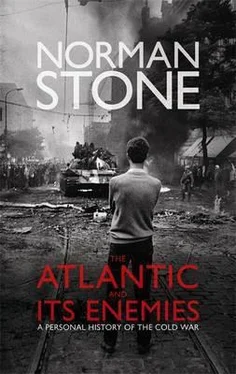The economy itself was losing the lead that it had had over all others, and, again, inflation had much to do with this. Unions, on the whole, could resist it, at least in the big industrial firms, where blue-collar wages kept up. Labour was all-important for the Democrats, and AFL-CIO grew, up to 1978, as ‘corporatism’ prevailed, but it was increasingly not so much blue-collar workers as soft-professional teachers in the lead. There were alarms as to the competitiveness of American industry. Kenneth Hopper, a Harvard Scottish warhorse, noted (‘American Machinist Special Report’ of July 1970) that output per hour in factories had increased by 20.1 per cent between 1961 and 1965, but by less than half of this figure in the following five years; the growth in take-home earnings fell from 23 per cent to −1.5. The point was that ‘of the major nations of the world, the US reinvests the lowest proportion of its GNP’ — 16.6 per cent as against 23 per cent in Germany and somewhat more in France, or 34 per cent in Japan, such investment including machinery and housing. In engineering, from the mid-fifties onwards, investment was far lower, per $1,000 deliveries, than in Europe or Japan (about $12 as against $60-80), and fixed assets were even below England’s. There was some official dishonesty involved in defence of this: a strange myth was propagated by the OECD that American equipment was only four to five years old, that investment had really been quite adequate, that overinvestment needed to be taxed. The Department of Commerce knew better. America, or parts of it, had been vastly spoiled and had not had to work; even in 1968 some essential structures were over fourteen years old. Congress sometimes ascribed the inflation to business’s desire for capital investment, but in fact new equipment was indeed needed, and what had confused the figures was tax. Depreciation allowances were unreal, and old equipment was recorded as relatively recent. There was also much grumbling that Americans had a low propensity to save (6.1 per cent of their income, whereas the German figure was 13 per cent and the Japanese 20 per cent). But only a fool would have saved in countries where inflation ran in double figures and interest rates in single (or, after tax, half of these).
This was an era when the vast industries and dam projects of the New Deal era lost ground. General Motors, ITT, Union Carbide, US Steel went on in the old way: Cadillacs and Chevrolets were much the same as before, representing strange and classless aspirations for boat-like motor cars; but the Japanese were more subtle. The American share of automobile sales went down from 32 to 19 per cent, of steel from 20 to 12 per cent, and in manufacturing generally from 26 to 20 per cent (1981). The standard of living fell below that of Germany or Sweden, as the GDP per head stood at $6,000 to Switzerland’s $7,000. All in all, much of American industry was now ‘rust belt’. The trade deficit with Japan rose ten times in a few years (to 1978) to $11bn and Japanese goods accounted for a quarter of imports. A good part of the economy appeared anyway to be unreal. In January 1968 credit card debt amounted to $1.5bn, 5 per cent of which went on car loans, and by 1982 grew to $64bn (and by 2004 $576bn). The great new fortunes were built on borrowed money, and inflation now helped to wipe out the debts. Meanwhile, governments struggled to find money for essentials, and America’s infrastructure was shockingly bad. The notion of a direct rail link between Kennedy airport and Manhattan was beyond America’s powers, and no new runway was added to Los Angeles airport between 1970 and 2000. Health care in the United States became yet another piece of black-humour surrealism: a great deal of money spent, but 50 million people not covered by the existing system, such that infant mortality was greater than in blockaded Cuba.
The Great Society was running into the sand, and so were the Democrats, now badly divided between Northern, liberal wing, Southern illiberal wing, and corrupted city-boss body. By this time, there was no commanding figure on the Democrat side to stand for the presidency, and ‘Jimmy’ Carter emerged, from a peanut farm; he had been Governor of Georgia. When his mother was told that he was standing for the presidency, she reacted: president of what? He scraped in with 40.8 million votes to Ford’s 39.1 million. Carter’s regime symbolized the era (1976-80). It was desperately well-meaning. It jogged; it held hands everywhere it went with its scrawny wife; it prayed, Baptist-fashion; it banned smoking where it could; it sent bossy women to preach human rights in places where bossy women were regarded as an affront to them. There was a whole lobby around these in the Carter administration, and it took over part of the State Department. Carter’s initial idea was to make the presidency popular: hence jumpers and jeans, and a dispersal of the Nixon trappings (the parade ground uniforms were sold to Bolivia). The man started his day at 6 a.m. and was generally exhausted; his wife was somewhat more ordered, and sometimes attended Cabinet meetings. There was fighting between the State Secretary, Cyrus Vance, who had had direct experience of Vietnam, and Zbigniew Brzezinski, as National Security Adviser, who resented the world’s not putting him on the same level as Henry Kissinger. He was one for verbiage: ‘the need is not for acrobatics but for architecture’ were his words of wisdom to the world. Carter was a hapless fellow, everything, sunny side up, curdling: even after his lengthy retirement, as he kept pushing himself forward as a sort of sexless Clinton, the pattern prevailed, as North Korea fired missiles over Japan about two weeks after Carter had announced that she did not have any, and as Haiti collapsed into mayhem after he had announced that the great and good had come to power there. There was a similarly naïve attitude to matters Soviet. Carter scrapped the B1 bomber unilaterally, and cancelled the neutron bomb (telling an enraged Schmidt only later). There was also an absurd neglect of the Soviet navy — the expansion of which went back to the Cuban Crisis in 1962, after which 1,323 ships of all classes were built, to the Americans’ 120 major surface battleships and 188 nuclear submarines. In 1975, through Cuban proxies, the Soviets moved into Angola; and Ethiopia collapsed, on the edge of the now volcanic Middle East.
This regime will be remembered only for its failures. Of these, inflation and the mismanagement of the oil problem were the worst, and together they badly weakened the country. The only success of the time was the Egyptian-Israeli agreement (Camp David in September 1978, followed by the treaty in March 1979, but its Egyptian maker, Sadat, despised Carter so much that he did not even say in advance that he proposed to visit Israel). Carter’s worst failure came over energy policy. The great problem was American. There was huge demand for the oil companies to be controlled because of what were said to be ‘obscene’ profits (the word probably intended was ‘obese’ but the misuse has stuck). True, the profits had been enormous, rising from $7bn in 1972 to $16.5bn two years later, because oil which had been bought at the old price was sold at the new, and chemical operations had also flourished, given the weakness of the dollar, which encouraged exports. But the companies had been nationalized abroad, and their profits overall were, if anything, somewhat below the American average. Besides, oil policy had become a terrible tangle. Nixon had imposed price controls in 1971, to stop the then prevailing inflation of 5 per cent, and these had been kept, with extraordinarily complicated rules, for oil. The standard reporting requirements for the Federal Register required 200,000 respondents and five million man-hours; and ‘for the oil industry [it] became more important than the geologist’s report’. The direct costs ran into thousands of millions, and there were tales of extraordinary waste and maladministration. The regulation was meant to ensure fair shares, and to bring back refineries that had been kept out of service. It seems only to have profited lawyers. Administrations lurched, unwilling to accept that the price mechanism was in the end valuable. President Gerald Ford, in January 1975, talked nuclear power and coal; ecologists went to town. However, two things were at last put through. The Alaskan Pipeline, set to cost $10bn, was allowed; and in 1975 American automobiles had to have fuel efficiency standards. In 1977 Carter took over, appointing a multipurpose warhorse, James Schlesinger, as his maker of energy policy, in effect hoping for rationing because a CIA report of 1976 had predicted another oil shortage. In his plaintive moralizing way, Carter wanted oil use to be subject to even greater regulation, and proclaimed (April 1977) ‘the moral equivalent of war’, subsequently dismissed as the acronym ‘MEOW’. The point was that US oil prices were well below the world level, with absurd effects — the US at times even subsidized imports. A complicated effort was now made to revive coal, and to loosen the controls on natural gas: a very good time for lobbyists. Utility companies, oil producers, liberals, ecologists, coal producers all fought, and Schlesinger himself said that the decontrolling of natural gas had been ‘Chinese water torture’.
Читать дальше












![Edward Ellis - Adrift on the Pacific - A Boys [sic] Story of the Sea and its Perils](/books/753342/edward-ellis-adrift-on-the-pacific-a-boys-sic-s-thumb.webp)